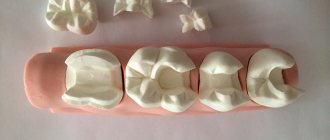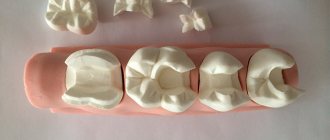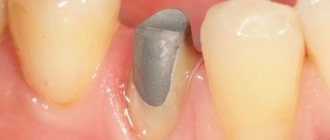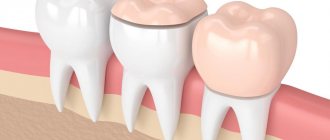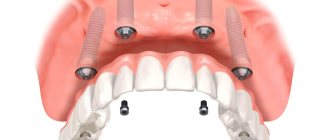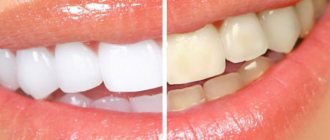In modern dentistry, there are many different methods for restoring damaged teeth - filling, prosthetics, installing inlays. The first two technologies are well known to patients, but few people know that teeth can be successfully restored with inlays.
What are tooth inlays, how do they differ from regular fillings, and in what cases is the use of inlays indicated? We will answer all these questions in detail in this article on our website.
What is it - a tooth tab?
Dental inlays are microprostheses that can be used for different purposes. Restorative or restorative inlays are used like fillings: they help recreate the natural crown of a tooth, keeping it alive. Stump inlays are used in cases where it is necessary to restore a badly damaged tooth under a crown. Let's take a quick look at why restoration and stump inlays are used, and find out the difference between them.
Restoring inlays are stronger than conventional dental fillings and differ from them in the technology of their creation: dental inlays are not made directly in the patient’s mouth, like fillings, but in a dental laboratory, using previously taken impressions. Because microdentures are made in a laboratory setting, they are also called indirect dental inlays.
The inlays exactly repeat the shape of the cavity that needs to be closed for tooth restoration and fit tightly to the natural tissues. The high density of adhesion of the inlay to the tooth tissue eliminates the risk of developing caries in the gap between the installed microprosthesis and the tooth. Restoring a tooth with an inlay will help keep the tooth alive in a situation where a sufficient amount of tooth tissue has been preserved, its nerve is alive and well, but a large filling still needs to be placed. Large fillings do not stick well to the teeth and can break under stress, along with the tooth. Inlays have a long useful life, can withstand chewing loads well, and their use makes it possible not to rush into dental prosthetics with a crown, which often requires preliminary depulpation of teeth.
Stump inlays for a tooth are no longer a restoration element, but a technical one. It acts as a support for the installation of a dental crown in cases where the tooth cannot be restored qualitatively with a conventional filling. In order not to confuse stump and restoration inlays, the easiest way to classify them is as follows: restorative inlays are installed outside the living tooth, stump inlays are always located under the crown.
This is the main classification of inlays, but they can also differ in the type of material they are made of, and below we will definitely talk about all the types of microprostheses and their features. But first, let's find out who and when is recommended to install inlays on teeth.
Indications for removing the stump tab, pin, dental instruments from the canal
Removing a post, onlay or endodontic file from a root canal while keeping the tooth suitable for prosthetics is not an easy task. It requires the dentist to have skill and experience in carrying out such manipulations, as well as the availability of appropriate tools and equipment. The procedure is carried out in several stages and requires the removal of a denture or filling, if they have been installed. Only after this can you begin to directly remove the fiberglass pin from the tooth or any other structure. Indications for the procedure:
- Violations committed by the dentist during treatment;
- Development of inflammatory processes in the root area and periodontal tissues;
- Development of caries and pain in the patient;
- Destruction of the dental unit under the crown.
As for fragments of endodontic instruments, the patient does not experience any unpleasant sensations when they come into contact with them. They appear much later and are manifested by the following symptoms:
- Discomfort and pain when biting on a tooth and chewing;
- Swelling of the gums in the area of the recently treated tooth;
- The appearance of a fistula in the oral cavity;
- Suppuration of soft tissues.
The above is a reason to promptly seek professional dental care. The dentist will prescribe a visiography, which will help identify foreign objects in the filled tooth. Thanks to it, it will be possible to establish the presence of caries or inflammation.
Particles from endodontic instruments must be removed, as they begin to rust and irritate the canal walls. As a result, the tooth root may crack and the tooth will have to be completely removed, since restoration in such a situation is not possible. Removing the instrument from the tooth canal is also necessary because:
- It will not allow it to be sealed properly, and as a result, the procedure will have to be carried out again;
- Its presence inside the canal is the cause of the development of serious inflammatory processes (if a fragment of a necrotic nerve remains under the fragment, it will rot).
It is for these reasons that refilling of root canals is carried out only after removing the instrument from the root canal.
Indications for dental restoration with inlays
Let's look at all the cases in which the use of tabs may be indicated. It is recommended to use tabs:
- If the tooth is destroyed by more than 1/3;
- With increased wear of chewing teeth;
- When restoring teeth that in the future will have to act as a support for a crown or installation of a bridge;
- For large carious cavities in the teeth, the elimination of which with conventional fillings is ineffective.
The need to use inlays is determined by the dentist during the examination of the patient. Based on the clinical situation, the specialist will choose the type of microprosthesis that is suitable for you, both in terms of functionality and material of manufacture.
Indications and contraindications for the installation of stump inlays
Installation of dental inlays is indicated in the following cases:
- crown inlay for prosthetics;
- fracture of the crown of the tooth;
- carious destruction of the crown;
- abnormalities in the position, shape or size of the tooth;
- low dental crown;
- production of a bridge prosthesis, when the stump inlay for the tooth is used as a supporting element;
- need for splinting.
The strength of fixation, quality of construction and durability of the product depend on the condition of the tooth root when a microprosthesis is installed into it. The root should not wobble, it should be free of curvature in the upper third, with passable and well-sealed canals and walls of sufficient thickness for prosthetics. The use of an abutment design is not recommended in the following cases:
- circular ligament damaged;
- resection of the root apex (temporary relative contraindication), as well as inflammatory processes that can injure the gums or root tissues;
- poor hygiene;
- incomplete obturation of the canals;
- mobility 3 degrees.
In each clinical case, the decision to place an abutment design is made by the treating orthopedic surgeon together with the relevant specialists, taking into account all the advantages and disadvantages of using this reconstruction. If there are relative (temporary) contraindications, therapeutic or corrective surgical treatment, as well as replacement of incompetent orthopedic structures, can be performed before prosthetics.
Types of restoration dental inlays: description, characteristics
In this section of the article, we will tell you about what restoration dental inlays can be, used in tooth restoration as an alternative to conventional fillings. Prostheses will be classified mainly according to the material of manufacture and according to this criterion, the inlays can be ceramic, composite, or metal. The material of the tooth inlay will affect both the performance characteristics of microprostheses and their cost.
Ceramic tooth inlay and its features
Most often, ceramic dental inlays are used to restore chips on living teeth and act as a high-quality and more reliable alternative to conventional fillings.
Ceramic inlays can only be placed on teeth that are alive, not loose, and have been treated for caries. Ceramic dental inlays have many advantages: they are aesthetically pleasing, durable, do not change their beautiful color even with prolonged use, and do not wear off. The high density of the marginal contact of the ceramic inlay with the natural tissues of the tooth eliminates the risk of developing secondary caries.
But ceramic dental inlays have some disadvantages. Some consider the disadvantages of ceramic inlays for teeth to be the high price of this type of microprosthesis in Moscow (from 8 thousand rubles), however, it should be noted that the high cost is fully justified by the long service life of ceramic inlays and their impeccable aesthetics. Please note that with ceramic inlays installed on your teeth, you will need to give up the habit of chewing nuts, crackers, and other types of too hard foods with your teeth. The ceramic inlay may not withstand such heavy loads!
Metal tooth tab: characteristics, pros, cons
Metal restoration inlays are used quite rarely these days, and all because microprostheses made from this material have a number of disadvantages:
- When installing metal inlays in the mouth, a very unpleasant galvanic side effect for the patient may occur, expressed in constant and profuse salivation, a pronounced metallic taste in the mouth;
- Installing metal inlays does not allow for high-quality and tight contact between the microprosthesis and the natural tissues of the tooth, and this increases the risk of developing secondary caries. Gold inlays on teeth can provide a good fit, but their price will be high, because gold is a noble and expensive metal;
- Metal inserts can cause allergic reactions;
- The aesthetics of metal inlays also leaves much to be desired.
The only significant advantage of metal inlays for teeth is the fairly low price for this type of microprosthesis in Moscow. The cost of a metal tab in the capital’s clinics starts at 4,000 rubles for one orthopedic product.
Composite inlays for teeth
Composite inlays are used to restore single-rooted teeth, which include incisors and canines, that is, the front teeth included in the smile area.
Installation of a composite inlay can only be carried out if the tissue in the tooth being restored is preserved in a volume of at least 50%. Composite inlays are also called pin inlays because when they are placed in the tooth canal, a pin is first placed on which the dentist will apply the composite material in layers. If the tooth is severely damaged, installing an inlay on a pin is not recommended, since over time the pin may begin to wobble in the tooth canal and its mobility can lead to a fracture of the tooth root. If your tooth is more than half destroyed, you do not need a restoration, but a stump inlay followed by installation of a crown!
How much will a composite tooth inlay cost? The answer to this question will depend on what type of post and composite material the dentist uses during the restoration process.
The price of a restoration insert will also depend on the method of its manufacture. All inlays, except composite ones, are created in the laboratory using dental impressions. The tooth for the inlay must be ground down, although the volume of tissue removed will be less than the amount of dental tissue that is removed for the crown. The most complex manufacturing technology is for ceramic crowns, which are made from pressed ceramics: they are created using CAD/CAM computer technology. The complexity of the technology increases the price of ceramic inlays, but such microprostheses will have high anatomical accuracy, which means they will last longer.
Sign up to install an E-Max tab at a discount:
But the most common material for dental inlays is ceramic?
Yes, today the most popular material for inlays is E-Max ceramics. This material is also used to make veneers. E-Max ceramics is a modern, aesthetic material that interacts very well with tooth tissue. Such an inlay is attached to the tooth adhesively; this is the strongest adhesion of ceramic restorations to the tooth’s own tissues. Thanks to this technology, the boundaries between the tooth and the inlay are practically invisible. The tooth and the tab fixed to it actually become one whole.
Is the tooth being filed down heavily under the inlay?
Almost the same as for a filling. The only thing is that the tooth tissue is cut down at certain angles, taking into account the installation of the inlay.
If a tooth is badly damaged, is it possible to put an inlay on it?
Yes, you can. Of course, most often inlays are placed on “living” (non-pulpless) teeth that have large cavities, that is, an inlay is placed instead of a large filling. But if necessary, the tab can also be placed on a “dead” (pulpless) tooth. The inlay can last on a “dead” tooth for several years without chipping or breaking.
But it is important to understand that a “dead” tooth does not receive nutrition and is more fragile, so if the load is incorrect, it can break.
Are dental inlays only placed on chewing teeth?
Most often, inlays are placed on chewing teeth. Veneers are usually installed on the front teeth.
Some people complain that after installing this micro dental prosthesis - inlays, the tooth hurts. Why does this happen and what to do in this case?
After the inlay is installed correctly, the tooth should not be disturbed. However, if this happened, then most likely the reason is that the doctor did not follow the procedure protocol
.
An assistant prepares the inlay before installation, and the doctor prepares the tooth. When installing a ceramic inlay, it is very important to isolate the tooth from saliva using a special latex scarf (rubber dam), which isolates the tooth from saliva so that no microflora gets on the prepared tooth. The tooth tissue is treated with a special liquid that eliminates sensitivity.
It should also be noted that all people have different sensitivity; for some, after dentures, the teeth ache during the first 2 weeks - which is normal; for others, they do not hurt at all.
So, if a patient’s tooth hurts for some time after the installation of an inlay, is there a possibility that this pain will subside over time?
Yes, sure. There are so-called “post-filling pains”. The treated tooth may ache for some time when biting after dental treatment. Therefore, it is necessary to give a certain time for recovery. This time varies for each patient, but on average up to one month.
And if the tooth does not subside and continues to hurt, what should you do?
The doctor must analyze the causes and nature of the pain. Often, painful sensations after dental treatment are due to the fact that the patient has an inflamed nerve due to the fact that he has caught a cold. It happens that this neuralgia is associated with stress. There are many reasons, and sometimes they are not related to the work of the dentist. Therefore, in case of pain, it is necessary not only to take photographs of the tooth (X-ray, computed tomography), check the sensitivity of the tooth with a special device, but also analyze the general condition of the patient.
Which tooth is better to place an inlay on – healthy or pulpless?
If possible, it is advisable to install the inlay on a living tooth. Before the procedure, the doctor takes an x-ray. Using it, a specialist looks at the condition of the dental canals and tissues located around the tooth. E-Max ceramics (I-Max) bond better with the tissues of living teeth. By examining an x-ray and the causative tooth in the patient’s mouth, the doctor decides what type of inlay or crown is best to install on the tooth. If it becomes clear to the doctor that the tab cannot withstand the load, then a crown is installed.
How are restoration inlays installed on teeth?
Installing a restorative inlay on teeth is a multi-step process that always begins with a detailed diagnosis, which will include examination, radiography and computed tomography. After the diagnosis, the type of inlay is selected and a detailed treatment plan is drawn up.
The tooth on which the inlay is planned to be placed is ground down and then an impression is taken from it and sent to a dental laboratory. An inlay will be made based on the impression and the average production time is 5-7 days.
When the inlay is ready, the patient is invited to the clinic for fitting and installation of a microprosthesis. The inlay is fixed in the tooth cavity using special dental cement.
Types of pins and features of their extraction and root canal
According to the material of manufacture, the pins are:
- Fiberglass - made from woven glass fibers that are arranged in a horizontal plane and embedded in an epoxy matrix. They are quite durable, and their physical characteristics are as close as possible to the native tooth tissues. For these reasons, they are used for restorations of frontal units. They do not show through the crowns, and their removal is not very difficult;
- Anchor - made of titanium, precious metals or stainless steel. Thanks to their special properties, it becomes possible to reconstruct even an almost completely destroyed unit, provided that its root is well preserved. They are fixed in the canal using phosphate cement. Destruction of the latter is possible only with the use of ultrasonic waves;
- Parapulpal – made of dental stainless steel with a polymer coating. They are used to strengthen fillings and are installed directly into hard dental tissues, which eliminates the risk of infection or inflammation. At the same time, the proximity of their location to the surface leads to the fact that they break teeth and require re-installation. To remove them, the dentist drills out a small amount of hard tooth tissue around it with a drill, and then carefully unscrews the structure.
Anchor pins are most often removed due to the development of secondary caries, but situations are possible when it is displaced during the process of chewing food and causes damage to the prosthesis. In the latter case, you will have to replace the entire structure, sometimes correction is possible. Unfortunately, it happens that violations are detected at a stage when treatment of the unit will not give the desired result - it is only possible to remove it along with the pin.
Is it possible to put an inlay on the front teeth?
Inlays are not used for the restoration of anterior teeth. If there is a sufficient amount of healthy tooth tissue, the tooth is restored with a regular filling and then a veneer or lumineer can be placed on it to obtain a beautiful aesthetic restoration in the smile area. If the tooth is severely damaged, then it makes sense to install a stump tab and then a crown.
The traditional area of application for restoration inlays is chewing teeth.
Why core inlays are better than fillings and pins
Fillings and pins are only applicable if the tooth has a sufficient amount of healthy tissue. If only the root or thin walls of the tooth remain, it will not be possible to restore it with a pin, since this restoration method will not differ in either quality or reliability.
Firstly, under load, the pin can break and damage the tooth root. Trauma to the root of a tooth is a direct indication for its removal; In case of damage to the root system, no technique will help save the tooth.
Secondly, dentures installed on large fillings and pins are more likely to fall out some time after prosthetics. In this case, the treatment will have to be repeated, and this entails new significant financial costs.
Important: Some dentists try to cement a fallen crown and post using cement. But this is useless - the structure will not hold firmly and, moreover, an inflammatory process can begin under it, which leads to caries.
Therefore, in the case of severe caries, only an abutment inlay can provide high-quality and durable prosthetic results.
Can a tooth get sick under an inlay and what to do if this happens?
If the tooth under the inlay hurts, you need to urgently contact a dental clinic, because pain under the installed microprosthesis can indicate the development of various kinds of complications. The main cause of complications after installing an inlay is medical errors that were made during the treatment process, and that is why it is so important to choose dentistry carefully! If, when treating a tooth, the doctor allows the pulp to overheat, an inflammatory process may begin, as a result of which the tooth under the tab will become sore. To eliminate pulpitis, you will have to remove the tooth inlay, receive appropriate treatment, and then restore the tooth again, possibly with a prosthetic crown or even implantation.
Inlays are often placed on teeth after caries treatment and it is extremely important that when working with a carious cavity, the dentist removes all destroyed tissue. If this is not done, secondary caries will begin under the tab, the treatment of which will again require removal of the tab.
Remember that if 5-7 days have passed after installing the inlay on the tooth, and your tooth hurts and the intensity of the pain is increasing, you need to urgently see a dentist, and not try to solve the problem yourself! If the infection gets into the root part of the tooth, it is not always possible to save the tooth and avoid its removal!
If the tooth does not hurt, but you have the feeling that it is bothering you - when eating, talking, trying to close your teeth - contact the clinic where you received the inlay to have its size corrected.
How to remove a tooth with a crown
Before the start of surgery, an X-ray examination is performed, which allows the doctor to understand the scale of the operation and outline the sequence of actions. When removing a tooth covered with a single crown, and there are suitable conditions in the bone for this, the doctor may suggest immediate implantation, i.e. implantation of a titanium root in place of an extracted tooth.
Extraction is always performed under local anesthesia. If a patient has dental phobia, then at the Refformat clinic he can be offered sleep treatment (the cost of 1 hour of sedation is 13,900 rubles).
Removing a tooth with a crown and inlay is a more complex operation due to the fact that the inlay along with the crown may separate from the tooth and then the doctor will have to remove it in parts.
After extraction, an anti-inflammatory and wound-healing material is inserted into the hole, which is absorbed as the wound heals. If, after removal, it was decided to undergo implantation, then the tooth is removed from the alveolar socket as carefully as possible, so that all its walls remain intact. The success of implantation and the degree of stabilization of the titanium pin depend on this. For the same purpose, the implant is “lined” with osteoplastic material. The doctor’s further actions depend on the area on which the operation was performed. If this is the front, the defect is closed with a temporary prosthesis, but if the removal was performed in the area of the chewing teeth, temporary structures are not necessary.
Stump inlays: what do you need to know about them?
At the very beginning of our article, we said that stump inlays should not be confused with restorative microprostheses - they are used to restore pulpless and severely damaged teeth, in which they will serve as the basis for installing a crown or dental bridge.
Stump inlays are structures consisting of two parts: a pin installed in the root canal and a support on which the crown will be fixed. Stump inlays can be monolithic or collapsible, and most often this type of structure is used when the tooth has less than 50% of healthy tissue left.
Many people are interested in the question: why is it best to use core inlays rather than fillings on a pin to restore severely damaged teeth? The fact is that the pin may not withstand the load and begin to wobble in the canal, and this will either lead to the filling breaking or falling out, or, worst of all, to damage to the tooth root, in which the tooth is most often removed. Stump inlays allow you to avoid such risks because they distribute the load more correctly and themselves have much greater strength compared to pins.
Stump inlays are also made in the laboratory and the construction material is selected to match the type of dental crown that is planned to be placed in the future. Metal core inlays are used for metal-ceramic crowns, and zirconium inlays are used for ceramic crowns. If you make a metal inlay for a ceramic crown, it can shine through the thin and transparent material of the crown, which will have a bad effect on the aesthetics of the restoration.
Tooth restoration using a core inlay will also be divided into several stages: diagnostics, preparation, during which a cavity is formed in the tooth for the inlay, manufacturing of the inlay, and its installation. After installing the core tab, the crown is fixed on it and this completes the process of tooth restoration.
If the tooth is destroyed, but there is a living nerve in it, before installing the stump tab, depulpation is carried out, as well as treatment and filling of the root canals. It is important that these procedures are carried out without errors, since poor canal processing leads to various kinds of complications, the elimination of which requires complex and lengthy treatment.
Pros and cons of stump inlays
A significant advantage of these microprostheses is their high reliability and preservation of the anatomical structure of the tooth. The root is intact, so the dental unit receives full load when chewing. This means that the bone tissue of the jaw does not degrade, and normal bite and diction are maintained.
The installation procedure is minimally invasive and usually easy to tolerate.
Tab lifespan
The service life of restoration inlays will depend on the material and production technology of microprostheses, as well as on how accurately the patient follows the dentist’s recommendations. Composite inlays last about 5-7 years, ceramic inlays - up to 20 years. This is subject to high-quality dental and oral hygiene and regular visits to the clinic for preventive examinations.
Stump inlays can last you a lifetime, and crowns on them last up to 15-20 years.
Do you still have questions about restorative and core dental inlays? Ask them to the orthopedists of our dentistry in Moscow - Vanstom! You can make an appointment with the clinic’s doctors at any time convenient for you - through the chat on our website, the call back form, or simply by dialing the contact phone number!
Rehabilitation period
If necessary, the doctor will prescribe medications and painkillers. It is equally important to follow a number of rules for the first 3-4 days that will prevent the development of complications:
- Do not rinse your mouth.
- Do not chew or brush your teeth on the extraction side.
- Do not take a hot bath or visit a bathhouse or sauna.
- Do not engage in sports or heavy physical labor.
- Avoid air travel (especially if the operation was on the upper jaw).
2-3 days after removal you should come for a follow-up examination, and after 5 days the sutures are removed.
To the list of posts
Making a core inlay for a crown
For the manufacture of stump pin inlays, direct and indirect methods are used. The direct method of manufacturing a stump insert has the following steps.
- After preliminary treatment of the tooth canals and its preparation for the stump inlay, the cavity is treated with Vaseline.
- The plastic, heated to a viscous state, is poured into a syringe and squeezed into the cavity through a wide needle to form an inlay.
- The pin is processed with the same material and inserted into the canal.
- After the plastic structure has hardened, the finished model of the inlay is removed from the cavity and sent to a dental laboratory for the manufacture of a microprosthesis from the material chosen by the patient.
The indirect method includes the following stages of manufacturing a stump inlay:
- After preliminary preparation of the tooth and canals, the doctor takes an impression and transfers it to the dental laboratory.
- The technician casts a plaster model and creates a prototype of the inlay from wax.
- Based on the wax sample, a metal stump inlay is made.
If we talk about stump inlays made of zirconium or ceramics, then CAD/CAM technologies are used for their production, which involve computer modeling of a microprosthesis, transferring the model to a milling machine and subsequent “cutting out” of the inlay from the workpiece.
